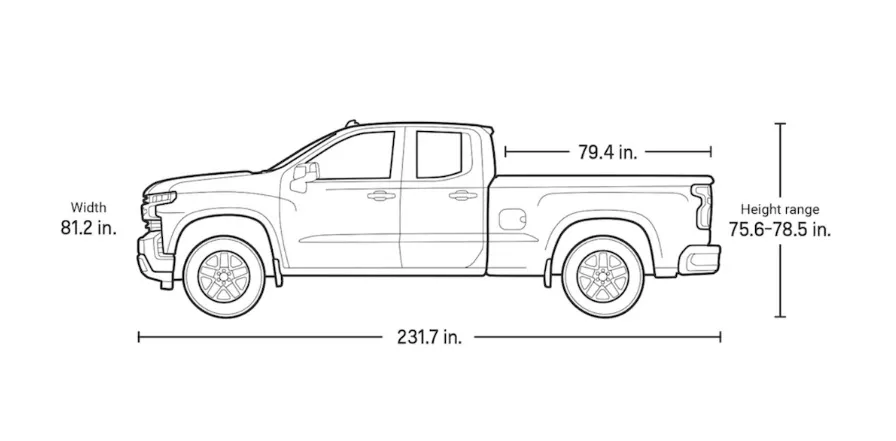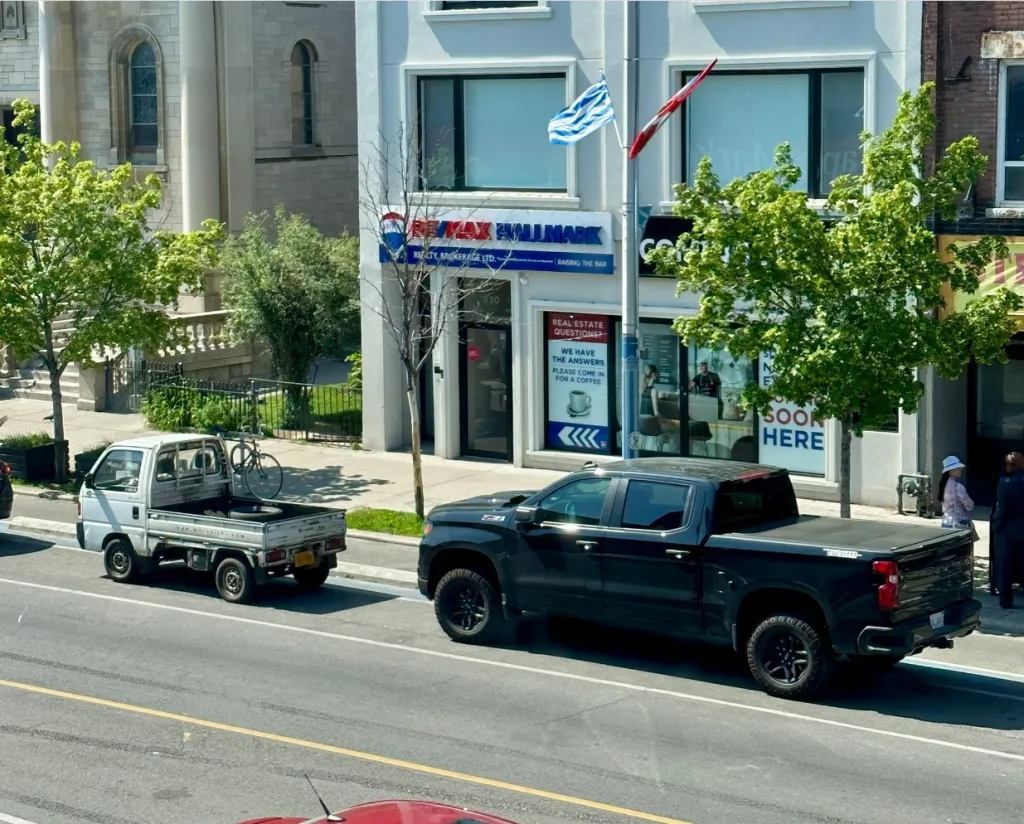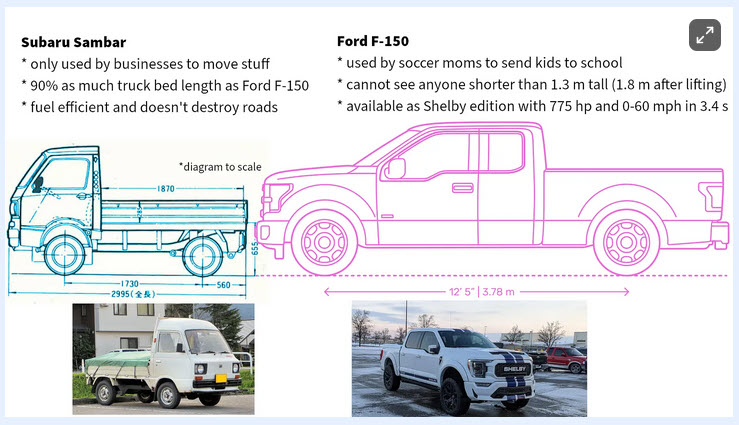Size Matters (Until It Doesn’t): The Kei Truck vs Pickup Showdown.
- the DREAM
- Oct 22
- 5 min read
Updated: Nov 5
Is this David and Goliath, or is this a case of bigger is always better? Today, we put the kei head-to-head with your typical choice of American truck nuts and see who comes out on top. Welcome to part 2 in our Kei versus Canada series: a side-by-side comparison of Kei performance against American full-sized trucks.

You know the story: one is small, scrappy, and ridiculously fuel-efficient. The other is a 6,000-lb steel linebacker that can tow a cabin if it wants to. But in a post-tariff, $90,000-pickup world, maybe it’s time to ask a dangerous question: do you really need a full-sized truck, or could a tiny 660cc kei handle 80% of your life just fine?
Welcome to part 2 of our Kei's versus Canada series: Kei's vs the full-sized pickup.
Let’s break it down, one lug nut at a time.
Sticker Shock: The Cost Reality Check
Here’s the ugly truth: new full-sized pickups have officially entered luxury-car pricing territory. A 2025 Ford F-150 starts around $54,495 CAD, while a mid-trim Lariat or King Ranch can climb past $85,000 CAD.
A Toyota Tundra hovers between $59,000–$92,000 CAD depending on options15-year-old models haven’t escaped inflation. A 2009 F-150 or Silverado with 150,000+ km still fetches $12,000–$18,000 CAD on Autotrader.ca
Now look at kei trucks. A 2008–2010 Suzuki Carry, Daihatsu Hijet, or Honda Acty, imported and landed in Canada, usually costs $7,500–$12,000 CAD — all in, including duty, inspection, and registration. In other words, you could buy five kei trucks for the price of one mid-trim F-150. Sure, you won’t tow a yacht with them… but you’ll have one for the farm, one for the cottage, one for deliveries, one for winter, and one to confuse your neighbors.
Payload and Practicality: Muscle vs Maneuverability
Let’s be real — kei trucks are not designed to haul bulldozers. Most models offer a 350–400 kg payload, 4WD, and a bed roughly the size of a large hot tub. A full-size truck, on the other hand, handles 900–1,500 kg payloads and can tow up to 5,000 kg with ease. Surprisingly, a kei's bed length of 6.7 feet (80.4 inches) is nearly the same as a 2021 Chevy Silverado pickup (pictured here).
But context matters. If your “hauling” consists of bags of mulch, construction tools, or a load of firewood, a kei truck will do it easily — and it’ll slip down your narrow cottage lane without folding in the mirrors. Full-sized trucks shine when towing boats or trailers long-distance, but they’re overkill for many day-to-day tasks.
You should also think about ground clearance — because while kei trucks can conquer your driveway like champs, they weren’t exactly born to summit Everest. Most kei’s come from the factory sitting low and polite, so if you plan to navigate that bumpy, rock-strewn deer trail behind the cottage, a 2–4 inch lift is money well spent. Expect to pay anywhere from $500–$2,000 CAD, depending on whether you’re doing the wrenching yourself or paying someone with fewer missing sockets.
Just remember: this is a kei truck, not a Rocky Mountain goat. Your average pickup laughs at clearance like this — and the big boys (duallies, full-bodies, and other rolling real estate) practically straddle small boulders for sport. Plus, thanks to their sheer mass and wider stance, their center of gravity offers more stability than a kei on a gravel road after three Tim Hortons double-doubles.
Fuel Economy: David Sips, Goliath Guzzles
This one’s not even close. Kei trucks average 6–7 L/100 km (~40 mpg), while full-sized gas trucks gulp 12–15 L/100 km (~18–22 mpg). Over a year, the average driver can save over $1,000 CAD in fuel with a kei truck — and that’s before factoring in cheaper tires, smaller oil changes, and lower insurance in many provinces.
Maintenance, Parts, and Politics: The Tariff Wild Card
Here’s where the plot thickens. In 2025, President Trump announced a 25% tariff on imported vehicles and auto parts. That means U.S.-built trucks that rely on foreign components — and most of them do — are about to get pricier to maintain. Automakers are warning of supply chain slowdowns and rising service costs
Even “Japanese” trucks aren’t immune. Toyota builds Tacomas and Tundras in U.S. plants, meaning some of their components could now be subject to tariffs. Toyota estimates the tariff hit at nearly $10 billion — and warned that continuing to absorb those costs is “not sustainable”.
Canada’s response? A retaliatory 25% tariff on non-USMCA-compliant U.S. vehicles.
So expect praices and maintenance costs to go upwards on that.
Oh... did I mention that we're 'not' in a trade war with Japan?
Creature Comforts: No Contest (And That’s Okay)
This is where full-sized trucks win hands-down. Infotainment systems, heated seats, adaptive cruise, lane-keeping — all stuff kei trucks don’t bother with. Most kei interiors are functional at best and spartan at worst. But that’s part of the appeal: no touchscreen that needs rebooting, no $1,200 radar sensor to replace when a snowbank kisses your bumper.
The kei's equivalent to this is a $50 battery-powered bluetooth speaker you bought at Walmart and syncs with your phone.
Lifespan & Ownership Strategy
Both kei trucks and pickups can easily pass 200,000 km with proper care. But depreciation works differently: a 15-year-old kei truck that cost $8,000 might still sell for $5,000, whereas a 15-year-old F-150 that cost $70,000 could be worth $12,000 — if it hasn’t rusted into a sculpture.
A growing number of Canadian owners are adopting the two-truck strategy: a kei truck for 80% of their chores (farm runs, deliveries, cottage duties) and a full-size truck for the occasional heavy lifting. It’s cheaper than running one expensive pickup year-round.
For Real, in 4K
For those of you who prefer the visual side of things, TFLoffroad put a Honda Acty up against a massive 2023 Ford F350. Check out as see how David fares against Goliath on the farm!
It gives you an up front perspective on what you practically can and can't do with a kei.
Or try this one from CarSauce and ejoy a review of the Suzuki Carry!
Or if you want to see it in the snow!
Though in fairness, you'll note the kei hasn't been raised and is NOT sporting snow tires . Still, it fares pretty darn well!
The Verdict: The Underdog Wins (Sometimes)
Full-sized pickups remain unbeatable for towing, hauling, long-distance comfort, and brute force. But kei trucks win on price, fuel economy, agility, and long-term operating costs — especially in a world where tariffs, trade wars, and rising repair bills are becoming part of truck ownership.
If your truck life is mostly short-distance chores, light hauling, and weekend jobs, a kei might surprise you. It’s not about replacing your pickup — it’s about asking whether you really need a sledgehammer for a job that a small, efficient wrench can do.
So what are our plans? Dreaming of a kei for the cottage? Or, are you fully behind your F150. Post in the comments below! WElcome






